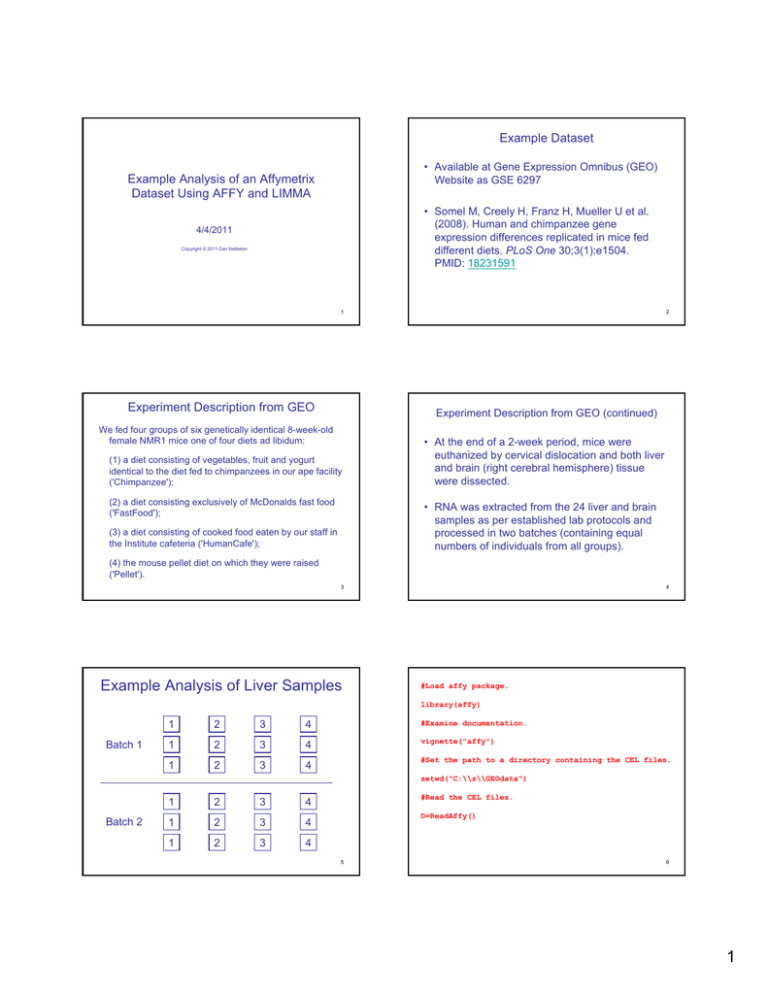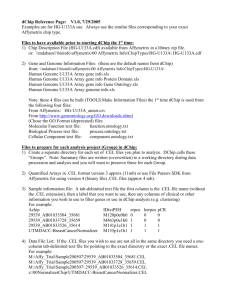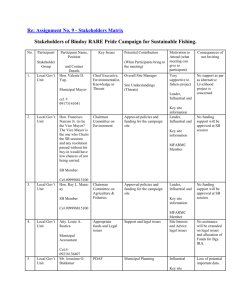Example Dataset Example Analysis of an Affymetrix Dataset Using AFFY and LIMMA
advertisement

Example Dataset
• Available at Gene Expression Omnibus (GEO)
Website as GSE 6297
Example Analysis of an Affymetrix
Dataset Using AFFY and LIMMA
• Somel M, Creely H, Franz H, Mueller U et al.
(2008). Human and chimpanzee gene
expression differences replicated in mice fed
different diets. PLoS One 30;3(1):e1504.
PMID: 18231591
4/4/2011
Copyright © 2011 Dan Nettleton
1
Experiment Description from GEO
2
Experiment Description from GEO (continued)
We fed four groups of six genetically identical 8-week-old
female NMR1 mice one of four diets ad libidum:
(1) a diet consisting of vegetables, fruit and yogurt
identical to the diet fed to chimpanzees in our ape facility
('Chimpanzee');
(2) a diet consisting exclusively of McDonalds fast food
('FastFood');
• At the end of a 2-week period, mice were
euthanized by cervical dislocation and both liver
and brain (right cerebral hemisphere) tissue
were dissected.
• RNA was extracted from the 24 liver and brain
samples as per established lab protocols and
processed in two batches (containing equal
numbers of individuals from all groups).
(3) a diet consisting of cooked food eaten by our staff in
the Institute cafeteria ('HumanCafe');
(4) the mouse pellet diet on which they were raised
('Pellet').
3
Example Analysis of Liver Samples
4
#Load affy package.
library(affy)
Batch 1
1
2
3
4
#Examine documentation.
1
2
3
4
vignette("affy")
1
2
3
4
#Set the path to a directory containing the CEL files.
setwd("C:\\z\\GEOdata")
Batch 2
1
2
3
4
1
2
3
4
1
2
3
4
#Read the CEL files.
D=ReadAffy()
5
6
1
D
AffyBatch object
size of arrays=1002x1002 features (15 kb)
cdf=Mouse430_2 (45101 affyids)
number of samples=24
number of genes=45101
annotation=mouse4302
notes=
Warning message:
package 'mouse4302cdf' was built under R version 2.12.1
attributes(D)
$.__classVersion__
R
Biobase
"2.12.0" "2.10.0"
$nrow
Rows
1002
$ncol
Cols
1002
$assayData
<environment: 049207f0>
$phenoData
An object of class "AnnotatedDataFrame"
sampleNames: GSM144707.CEL GSM144708.CEL ...
GSM144730.CEL (24 total)
varLabels: sample
varMetadata: labelDescription
eSet AffyBatch
"1.3.0"
"1.2.0"
$cdfName
[1] "Mouse430_2"
7
$featureData
An object of class "AnnotatedDataFrame": none
$featureData
An object of class "AnnotatedDataFrame": none
8
$protocolData
An object of class "AnnotatedDataFrame"
sampleNames: GSM144707.CEL GSM144708.CEL ...
GSM144730.CEL (24 total)
varLabels: ScanDate
varMetadata: labelDescription
$experimentData
Experiment data
Experimenter name:
Laboratory:
Contact information:
Title:
URL:
PMIDs:
No abstract available.
Information is available on: preprocessing
notes:
:
$class
[1] "AffyBatch"
attr(,"package")
[1] "affy"
$annotation
[1] "mouse4302"
9
10
sampleNames(D)
[1]
[5]
[9]
[13]
[17]
[21]
"GSM144707.CEL"
"GSM144711.CEL"
"GSM144715.CEL"
"GSM144719.CEL"
"GSM144723.CEL"
"GSM144727.CEL"
"GSM144708.CEL"
"GSM144712.CEL"
"GSM144716.CEL"
"GSM144720.CEL"
"GSM144724.CEL"
"GSM144728.CEL"
"GSM144709.CEL"
"GSM144713.CEL"
"GSM144717.CEL"
"GSM144721.CEL"
"GSM144725.CEL"
"GSM144729.CEL"
"GSM144710.CEL"
"GSM144714.CEL"
"GSM144718.CEL"
"GSM144722.CEL"
"GSM144726.CEL"
"GSM144730.CEL“
#Sometimes phenoData(D) will contain information about
#how to match the CEL files to treatment information.
#In this case, that information must be taken from
#the GEO database.
Batch 1
diet=rep(1:4,each=6)
batch=rep(rep(1:2,each=3),4)
rbind(diet,batch)
[,1] [,2] [,3] [,4] [,5] [,6] [,7] [,8] [,9] [,10] [,11] [,12] [,13]
diet
1
1
1
1
1
1
2
2
2
2
2
2
3
batch
1
1
1
2
2
2
1
1
1
2
2
2
1
[,14] [,15] [,16] [,17] [,18] [,19] [,20] [,21] [,22] [,23] [,24]
diet
3
3
3
3
3
4
4
4
4
4
4
batch
1
1
2
2
2
1
1
1
2
2
2
11
19th GeneChip
1st GeneChip
Batch 2
6th GeneChip
1
2
3
4
1
2
3
4
1
2
3
4
1
2
3
4
1
2
3
4
1
2
3
4
12
2
#We can examine PM densities for all GeneChips.
hist(D)
#We can examine PM densities for subsets of GeneChips.
hist(D[,batch==1],main="PM Densities for Batch 1")
hist(D[,batch==2], main="PM Densities for Batch 2")
#Make side-by-side boxplots of log2 PM
#color-coded by batch (red=1,blue=2)
boxplot(D,axes=F,xlab="GeneChip",ylab="log2 PM",
col=2*batch)
axis(1,labels=
paste(diet,batch,substr(sampleNames(D),8,9),sep=""),
at=1:24,las=3)
axis(2)
box()
13
14
15
16
#See an image of GeneChip 18.
image(D[,18])
17
18
3
#Store probeset IDs and examine first 10.
#Examine PM data for 10th probeset and a subset of chips.
pm(D, gn[10])[,11:20]
gn=geneNames(D)
gn[1:10]
[1] "1415670_at"
[6] "1415675_at"
"1415671_at"
"1415672_at"
"1415676_a_at" "1415677_at"
"1415673_at"
"1415678_at"
"1415674_a_at"
"1415679_at"
#Shorten sample names.
sampleNames(D)=
paste("GC",substr(sampleNames(D),8,9),sep="")
sampleNames(D)
[1] "GC07" "GC08" "GC09" "GC10" "GC11" "GC12"
[7] "GC13" "GC14" "GC15" "GC16" "GC17" "GC18"
[13] "GC19" "GC20" "GC21" "GC22" "GC23" "GC24"
[19] "GC25" "GC26" "GC27" "GC28" "GC29" "GC30"
19
1415679_at1
1415679_at2
1415679_at3
1415679_at4
1415679_at5
1415679_at6
1415679_at7
1415679_at8
1415679_at9
1415679_at10
1415679_at11
GC17 GC18 GC19 GC20 GC21 GC22 GC23 GC24 GC25 GC26
406 385 327 384 361 333 347 455 406 418
717 619 424 593 495 405 508 711 585 634
515 564 583 675 573 416 447 523 701 687
201 156 145 170 146 102 153 222 150 178
475 447 315 468 474 248 406 525 478 509
798 808 766 854 1017 477 721 777 1060 947
393 446 296 353 382 252 358 418 447 404
586 579 545 605 582 505 552 634 699 665
237 206 216 258 280 144 198 282 295 328
384 391 329 533 392 337 378 435 470 483
551 551 432 546 533 407 489 551 593 591
20
#Examine PM and MM data for first GeneChip.
cbind(pm(D, gn[10])[,1],mm(D, gn[10])[,1])
1415679_at1
1415679_at2
1415679_at3
1415679_at4
1415679_at5
1415679_at6
1415679_at7
1415679_at8
1415679_at9
1415679_at10
1415679_at11
[,1] [,2]
362 224
561 366
630 184
155 108
542 128
959 311
397
84
702 151
336 123
467 112
518 148
plot(rep(1:11,2),c(pm(D, gn[10])[,1],mm(D, gn[10])[,1]),
pch=rep(c("p","m"),each=11),col=(rep(c(4,2),each=11)),
ylim=c(0,1000),xlab="Probe",ylab="Intensity")
21
22
23
24
#Find the proportion of MM that exceed PM.
mean(pm(D)<mm(D))
[1] 0.3181409
#Plot PM difference (M) vs. PM average (A)
#for some GeneChip pairs.
library(geneplotter)
MAplot(D[,c(1,2,10)], pairs = TRUE,
plot.method = "smoothScatter")
4
#Perform RMA normalization.
#Create a data matrix with a row for each probeset
#and a column for each GeneChip.
r=rma(D)
Background correcting
Normalizing
Calculating Expression
d=exprs(r)
dim(d)
[1] 45101
r
ExpressionSet (storageMode: lockedEnvironment)
assayData: 45101 features, 24 samples
element names: exprs
protocolData
sampleNames: GC07 GC08 ... GC30 (24 total)
varLabels: ScanDate
varMetadata: labelDescription
phenoData
sampleNames: GC07 GC08 ... GC30 (24 total)
varLabels: sample
varMetadata: labelDescription
featureData: none
experimentData: use 'experimentData(object)'
Annotation: mouse4302
25
1415670_at
1415671_at
1415672_at
1415673_at
1415674_a_at
1415675_at
1415670_at
1415671_at
1415672_at
1415673_at
1415674_a_at
1415675_at
1415670_at
1415671_at
1415672_at
1415673_at
1415674_a_at
1415675_at
26
boxplot(as.data.frame(d),las=3,col=2*batch)
head(d)
1415670_at
1415671_at
1415672_at
1415673_at
1415674_a_at
1415675_at
24
GC07
5.814663
8.143719
7.859956
3.611563
5.784022
5.423964
GC14
6.010483
8.114104
8.094428
3.668004
6.192669
5.482453
GC21
6.179215
8.311479
8.332273
4.104580
5.834398
5.196933
GC28
5.836999
8.067470
7.814227
3.761913
5.773049
5.338097
GC08
6.181183
8.285620
7.729129
3.691870
5.854410
5.474299
GC15
5.858698
8.371491
8.537742
3.694028
6.134427
5.300695
GC22
5.277738
8.103617
7.752824
3.579261
5.885129
5.540621
GC29
5.942128
8.059384
7.858566
3.746422
6.072727
5.316445
GC09
6.361403
8.484586
7.674707
3.670835
6.051814
5.497647
GC16
5.321736
8.204701
8.095201
3.714788
5.665400
4.932934
GC23
5.241534
7.905654
8.145597
3.610670
5.692189
5.066987
GC30
6.129787
8.197599
8.216948
3.912751
6.282062
5.126147
GC10
5.027124
7.642196
7.148700
3.868315
5.103153
4.691470
GC17
4.549718
7.427503
7.362150
3.605294
5.417380
5.124335
GC24
4.508605
7.423459
7.254621
3.537173
5.176930
4.901728
GC11
4.540326
7.544798
7.333395
3.504496
5.171708
5.154246
GC18
5.268545
8.096952
8.124529
3.677794
5.692752
5.095452
GC25
6.597141
8.416838
8.446753
4.188005
6.599257
5.294258
GC12
5.194070
7.883108
7.753031
3.817986
5.623301
4.791819
GC19
5.606858
8.185465
8.138183
3.564698
6.041425
5.268749
GC26
6.149816
8.373552
8.079930
3.760504
6.315471
5.387153
GC13
5.883083
8.326789
8.118746
3.984547
6.273496
5.469426
GC20
5.921809
8.251371
8.152899
3.660264
6.110461
5.542943
GC27
6.447506
8.441539
8.212414
4.054429
6.249057
5.547708
27
#To keep the example simple, we will go through
#an analysis for the Batch 1 data.
28
library(limma)
#R uses "set first to zero" constraint by default.
d1=d[,batch==1]
diet=factor(diet[batch==1])
diet
design=model.matrix(~diet)
design
(Intercept) diet2 diet3 diet4
1
1
0
0
0
2
1
0
0
0
3
1
0
0
0
4
1
1
0
0
5
1
1
0
0
6
1
1
0
0
7
1
0
1
0
8
1
0
1
0
9
1
0
1
0
10
1
0
0
1
11
1
0
0
1
12
1
0
0
1
[1] 1 1 1 2 2 2 3 3 3 4 4 4
Levels: 1 2 3 4
29
30
5
#In this case it may be more convenient to
#use a treatment mean parameterization.
#Name the columns of the design matrix.
#This is equivalent to naming the parameters
#in the regression vector.
design=model.matrix(~0+diet)
design
1
2
3
4
5
6
7
8
9
10
11
12
colnames(design)=c("u1","u2","u3","u4")
diet1 diet2 diet3 diet4
1
0
0
0
1
0
0
0
1
0
0
0
0
1
0
0
0
1
0
0
0
1
0
0
0
0
1
0
0
0
1
0
0
0
1
0
0
0
0
1
0
0
0
1
0
0
0
1
#Fit linear model for each gene.
fit=lmFit(d1,design)
#Set up contrasts of interest.
#In this case, we consider all pairwise
#comparisons between treatment means.
contr.mat=makeContrasts(u1-u2,u1-u3,u1-u4,
u2-u3,u2-u4,u3-u4,
levels=design)
31
32
#Estimate contrasts.
#Compare variance estimates before and after shrinkage.
fit2=contrasts.fit(fit,contr.mat)
plot(log(fit3$sigma),log(sqrt(fit3$s2.post)),
xlab="Log Sqrt Original Variance Estimate",
ylab="Log Sqrt Empirical Bayes Variance Estimate")
lines(c(-99,99),c(-99,99),col=2)
lsrs20=log(sqrt(fit3$s2.prior))
abline(h=lsrs20,col=4)
abline(v=lsrs20,col=4)
#Conduct analysis based on Smyth's
#empirical Bayes approach.
fit3=eBayes(fit2)
#Estimates of parameters in the prior on
#the gene-specific error variances.
fit3$df.prior
[1] 4.477159
fit3$s2.prior
[1] 0.01307461
33
34
#Examine p-values for F-test whose null says
#that all contrasts in contr.mat are
#simultaneously zero. In this case, that is
#equivalent to H_0:u1=u2=u3=u4.
hist(fit3$F.p.value,col=4)
box()
35
36
6
#Examine p-values for pairwise comparisons.
p=fit3$p.value
dim(p)
[1] 45101 6
hist(p[,1],col=4,cex.lab=1.5,
xlab="p-value",
ylab="Number of Probesets",
main="Chimp Diet Mean vs. Fast Food Diet Mean")
box()
.
.
.
37
hist(p[,6],col=4,cex.lab=1.5,
xlab="p-value",
ylab="Number of Probesets",
main="Cafe Diet Mean vs. Pellet Diet Mean")
38
box()
39
40
41
42
7
43
#Load some multiple testing functions.
44
#For each pairwise comparison, find
#number of genes declared significant
#at an estimated FDR level of 0.05.
source("http://www.public.iastate.edu/~
dnett/microarray/multtest.txt")
apply(qvalues<=0.05,2,sum)
#Estimate proportion of true nulls
#for each pairwise comparison.
u1 - u2
113
u1 - u3
44
u1 - u4
1658
u2 - u3
1
u2 - u4
371
u3 - u4
612
apply(p,2,estimate.m0)/nrow(d1)
u1 - u2
u1 - u3
u1 - u4
u2 - u3
u2 - u4
u3 - u4
0.8682734 0.9418860 0.8249632 0.9839767 0.9472074 0.9017337
#Separately for each column of p,
#convert p-values to q-values.
qvalues=apply(p,2,jabes.q)
45
46
#Find probeset IDs of some significant genes.
row.names(d1)[qvalues[,2]<=0.05]
[1]
[4]
[7]
[10]
[13]
[16]
[19]
[22]
[25]
[28]
[31]
[34]
[37]
[40]
[43]
"1416029_at"
"1417761_at"
"1418654_at"
"1420731_a_at"
"1422257_s_at"
"1425300_at"
"1426159_x_at"
"1428004_at"
"1429735_at"
"1436902_x_at"
"1438377_x_at"
"1442026_at"
"1449375_at"
"1453080_at"
"1455065_x_at"
"1416184_s_at"
"1417883_at"
"1418833_at"
"1421258_a_at"
"1423078_a_at"
"1425303_at"
"1427747_a_at"
"1428093_at"
"1435455_at"
"1437185_s_at"
"1438711_at"
"1448619_at"
"1451122_at"
"1453345_at"
"1455439_a_at"
"1417219_s_at"
"1418474_at"
"1419146_a_at"
"1421259_at"
"1425252_a_at"
"1425645_s_at"
"1427883_a_at"
"1429272_a_at"
"1436504_x_at"
"1438322_x_at"
"1439566_at"
"1448898_at"
"1451787_at"
"1454161_s_at"
47
8






